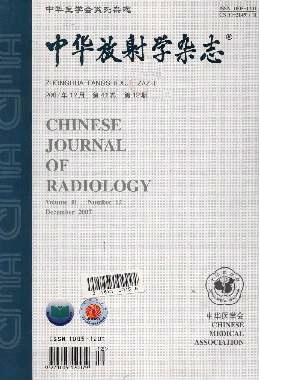The value of tumor hemodynamics and morphological features in predicting the postoperative recurrence time of breast cancer based on dynamic contrast-enhanced MRI
Q4 Medicine
Zhonghua fang she xue za zhi Chinese journal of radiology
Pub Date : 2020-03-10
DOI:10.3760/CMA.J.ISSN.1005-1201.2020.03.007
引用次数: 0
Abstract
Objective To investigate the value of tumor hemodynamics and morphological features from conventional dynamic contrast-enhanced MRI (DCE-MRI) scan before surgery in predicting postoperative recurrence time in breast cancer patients. Methods A retrospective analysis of 58 patients with breast cancer who had recurred after operation from November 2012 to December 2014 in Liaoning Cancer Hospital was performed. According to the recurrence time, the patients were divided into early recurrence group (≤2 years after surgery, 33 cases) and late recurrence group (>2 years after surgery, 25 cases). All patients underwent routine DCE-MRI scans before surgery, and hemodynamic features of the three-dimensional volume of the tumor and the morphological and textural features of the tumor in each phase were extracted by computer. The counts and measurement data of patients in early recurrence group and late recurrence group were compared by Fisher′s exact probability method and Mann-Whitney U test, and receiver operating characteristic (ROC) curves were drawn. The multivariate logistic regression was used to calculate the combined efficacy in predicting early recurrence and late recurrence. Kaplan-Meier method was used to analyze the survival prognosis, and Log-Rank test was used to compare the differences in survival curves between groups. Results There was no significant difference in background parenchymal enhancement, lesion margin, lesion internal enhancement characteristics, lesion morphology, time-signal intensity curve type and the degree of whole-breast vascularity increase between early recurrence and late recurrence groups (P>0.05).There were significant differences in the maximum concentration of contrast (Max Conc), the area under the time signal curve (AUC) and the maximum slope value of the time signal curve (Max Slope) (P<0.05). Comparative analysis of the radiomics parameters of 8 phases DCE-MRI found that the sphericity of morphological characteristic parameters in the phase 3 was statistically different between the early recurrence and late recurrence groups (P=0.03). Area under the ROC curve of AUC, Max Conc, Max Slope and parameter sphericity of phase 3 morphological characteristics for predicting early and late recurrence were 0.664, 0.659, 0.684 and 0.670, respectively. The area under the ROC combined with the above four parameters for prediction was 0.765, with a specificity of 63.6% and a sensitivity of 84.0%; the predictive efficacy was higher than that of univariate. Fifty-eight patients were followed up for 17 to 64 months with a median follow-up of 47 months. The disease-free survival and overall survival in the early recurrence group were significantly lower than those in the late recurrence group, and the difference was statistically significant (P<0.05). Conclusion It is of certain value to predict the postoperative recurrence time of breast cancer based on the tumor hemodynamic characteristics combined with morphological characteristics from preoperative non-invasive conventional DCE-MRI. Key words: Breast neoplasms; Magnetic resonance imaging; Texture analysis; Recurrence基于动态增强MRI的肿瘤血流动力学和形态学特征预测癌症术后复发时间的价值
目的探讨癌症患者术前常规动态增强MRI(DCE-MRI)扫描的肿瘤血流动力学和形态学特征对预测术后复发时间的价值。方法对辽宁省癌症医院2012年11月至2014年12月收治的58例术后复发的癌症患者进行回顾性分析。根据复发时间,将患者分为早期复发组(术后≤2年,33例)和晚期复发组(手术后>2年,25例)。所有患者在手术前均进行了常规DCE-MRI扫描,并通过计算机提取肿瘤三维体积的血液动力学特征以及每个阶段肿瘤的形态和质地特征。采用Fisher精确概率法和Mann-Whitney U检验对早期复发组和晚期复发组患者的计数和测量数据进行比较,绘制受试者工作特性(ROC)曲线。多变量逻辑回归用于计算预测早期复发和晚期复发的综合疗效。Kaplan-Meier法用于分析生存预后,Log-Rank检验用于比较各组之间生存曲线的差异。结果早期复发组与晚期复发组在背景实质增强、病变边缘、病变内部增强特征、病变形态、时间信号强度曲线类型和全乳血管增加程度等方面无显著差异(P>0.05),时间信号曲线下面积(AUC)和时间信号曲线最大斜率值(Max slope)(P<0.05)。对8期DCE-MRI放射组学参数的比较分析发现,早期复发组和晚期复发组3期形态特征参数的球形度有统计学差异(P=0.03),预测早期和晚期复发的3期形态特征的最大Conc、最大Slope和参数球度分别为0.664、0.659、0.684和0.670。ROC下面积结合上述四个参数预测为0.765,特异性为63.6%,敏感性为84.0%;预测疗效高于单因素预测。58名患者接受了17至64个月的随访,中位随访时间为47个月。早期复发组的无病生存率和总生存率显著低于晚期复发组,结论根据肿瘤血流动力学特征结合术前无创常规DCE-MRI的形态学特征预测癌症术后复发时间具有一定价值。关键词:乳腺肿瘤;磁共振成像;纹理分析;重复
本文章由计算机程序翻译,如有差异,请以英文原文为准。
求助全文
约1分钟内获得全文
求助全文
来源期刊

Zhonghua fang she xue za zhi Chinese journal of radiology
Medicine-Radiology, Nuclear Medicine and Imaging
CiteScore
0.30
自引率
0.00%
发文量
10639
 求助内容:
求助内容: 应助结果提醒方式:
应助结果提醒方式:


